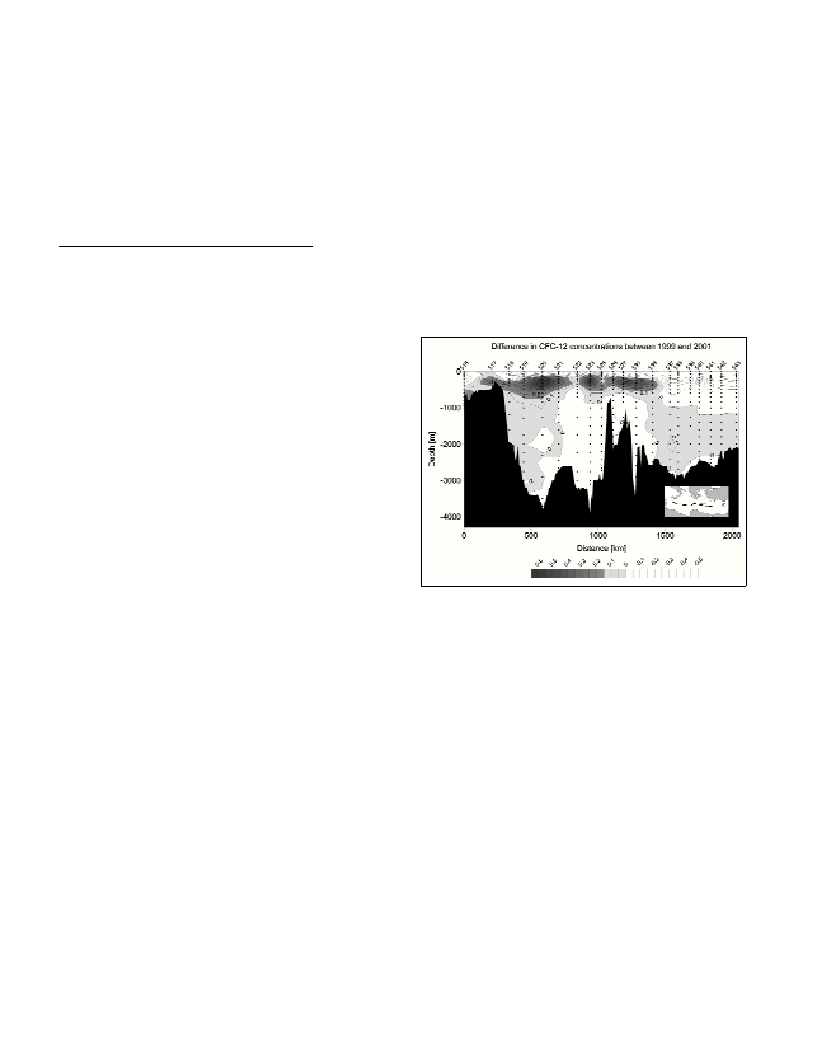Rapp. Comm. int. Mer Médit., 37,2004
111
THE EVOLUTION OF THE INTERMEDIATE WATER MASSES OF THE EASTERN MEDITERRANEAN
Birgit Klein
1*
, Beniamino Bruno Manca
2
and Wolfgang Roether
2
1
University of Bremen, Inst.of Environmental Physics, Bremen, Germany,
* bklein@physik.uni-bremen.de and wroether@physik.uni-bremen.de
2
Istituto Nazionale di Oceanografia e di Geofisica Sperimentale - OGS, Borgo Grotta Gigante 42/c, 34010 Sgonico (Trieste), Italy
bmanca@ogs.trieste.it
Abstract
Hydrographic observations in 1999 and 2001 are used to highlight the evolution in the intermediate water masses. During the current stage
of the Eastern Mediterranean Transient the Aegean is an active source of a warm and highly saline intermediate water mass. The
distributions of the tracer CFC-12 show that the Cretan Intermediate Water (CIW) is strongly ventilated and is now spreading along the
main pathways of Levantine Intermediate Water towards the Strait of Sicily.
Keywords: Intermediate waters, ventilation, tracer
Introduction
The Eastern Mediterranean Transient (EMT) is a major
disturbance of the thermohaline circulation of the Eastern
Mediterranean. It started in the early 1990s, when the Aegean took
over the leading role in deep water production from the Adriatic.
One of the most prominent features during the early stages of the
EMT had been the massive ventilation of the deep water masses.
This could be seen very clearly in the strongly increased
concentrations of the tracer CFC-12. As a side effect of the
massive out?ow of dense water from the Aegean ‚old‘ Eastern
Mediterranean Deep Water (EMDW) was pushed upward and
diluted the Levantine Intermediate Water (LIW) layer, causing
salinities to decrease. The evolution of the intermediate waters is
of great interest because the salt they are transporting is an
important prerequisite to achieve high densities during
convection. The initial decrease of salinity in the LIW had been
linked to the lack of convective activity in the Adriatic during the
1990s and it had been postulated that the resumed salt advection
into the Adriatic by the Cretan Intermediate Water (CIW) would
help the Adriatic to regain its leading role in deep water
production [1, 2].
Materials and Methods
The data presented in this study have been obtained during two
cruises of RV METEORin April/May 1999 and October/
November 2001 in the Eastern Mediterranean. The data comprise
hydrographic profiles, nutrient and oxygen profiles, as well as
profiles of transient tracers (CFCs, helium isotopes, and tritium).
Atmospheric concentrations of CFCs display a time-dependant
behaviour. CFCs are introduced into the ocean by air/sea gas
exchange and carry the time-varying signal into the ocean. They
are therefore excellent tools to identify ventilation and spreading
pathways of water masses.
Results and Discussion
Figure 1 shows the change in concentration of CFC-12 between
1999 and 2001 along an east/west transect in the Eastern
Mediterranean. The evolution of CFC-12 between 1999 and 2001
shows only moderate increases in the deep water (H>1500m). One
area of increase is observed close to the Italian continental break
and the other is seen in the Levantine Basin, where spreading of
the dense water from the Aegean is still continuing. Whereas a
very strong signal of ventilation is observed in 200-400 m depth
range. This signal is persistent from the eastern Straits of the
Cretan Arc toward the Strait of Sicily but is absent in the
Levantine Basin. A closer examination of the T/S properties
shows that the CFC-12 increase is associated with the Cretan
Intermediate Water. CIW is warmer and saltier than LIW and
therefore is found on top of the LIW in the water column. In the
salinity profiles CIW and LIW overlap into large subsurface
salinity maximum, but the CFC-12 distributions clearly mark
CIW as the more ventilated water mass and allow the separation
of the two intermediate water masses. In 1999 CIW had not been
found in the Cretan Passage, but was exchanged through
Antikythera Strait into the Ionian and advected into the Adriatic.
The salt advected into the Adriatic by the CIW and previously the
LIW is a prerequisite for deep convection in the southern Adriatic.
The 2001 observations indicate that CIW is now following one of
the main spreading pathways of LIW, ?owing westward towards
the Strait of Sicily and is thus included into the exchange of water
masses between the Eastern and Western Mediterranean. In the
Levantine Basin the CFC-12 differences between 1999 and 2001
indicate decreasing concentrations. This results from the absence
of CIW and from the still ongoing upward movement of ‚old‘
EMDW into the LIW horizon.
Fig. 1. Difference in CFC-12 concentrations [pmol/kg] between 2001 and
1999 along a section between Sicily and Cyprus. Positive values corre-
spond to an increase in CFC-12 from 1999 to 2001, negative values
denote a decrease.
References
1-Klein, B., W. Roether, G. Civitarese, M. Gacic, B. Manca, M. Ribera
d’Alcala, 2000. Is the Adriatic returning to dominate the production of
Eastern Mediterranean deep water?, Geophys. Res. Letters, Vol. 27 (20):
3377-3380.
2-Manca B.B., Budillon G., Scarazzato P., Ursella L., 2003. Evolution of
dynamics in the eastern Mediterranean affecting water masses structures
and properties in the Ionian and Adriatic Seas, J. Geophys. Res.,
108(C9),8102, doi:10.1029/2002JC001664.

